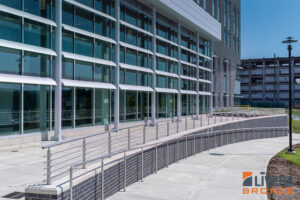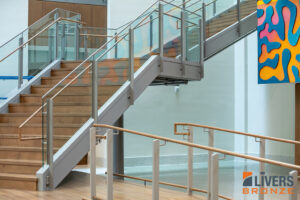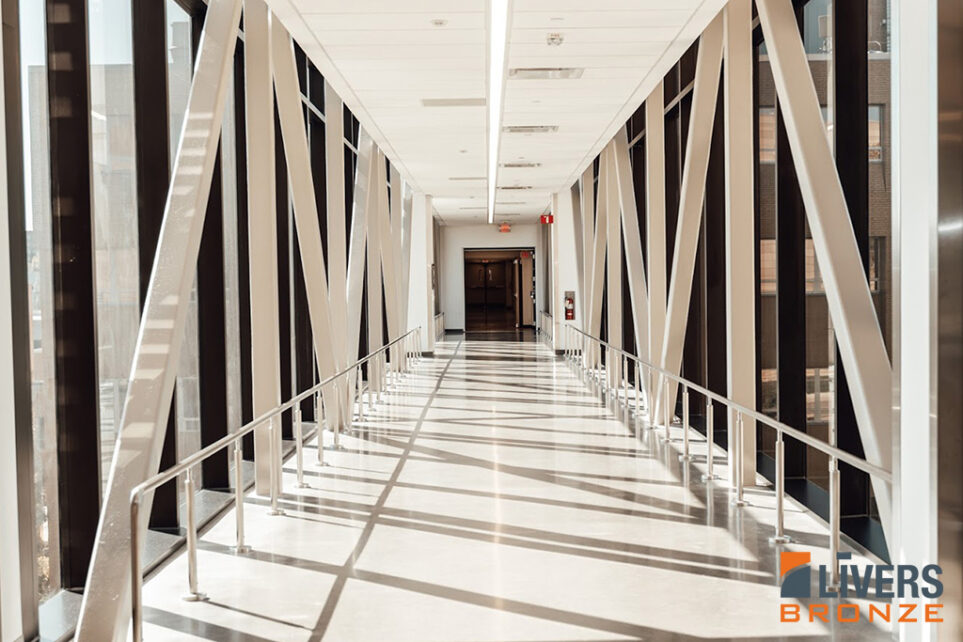Introduction
In the realm of commercial building design, railings serve as critical elements for ensuring safety and accessibility. Among the different types of railings, guard railings and hand railings play distinct roles in protecting individuals and providing support. Understanding their differences and applications is essential for creating functional and compliant commercial spaces. In this blog, we will delve into the disparities between guard railings and hand railings, exploring how they are utilized in commercial building spaces. Additionally, we will highlight the expertise of Livers Bronze Railings as a leading provider of railing solutions for commercial projects.
Guard Railings: Safeguarding Against Falls and Hazards
Guard railings are designed to prevent falls and protect individuals from hazardous areas with significant height differentials. They serve as a physical barrier, creating a protective enclosure and dissuading accidental access. Guard railings are typically taller and sturdier compared to hand railings to provide robust protection.
In commercial building spaces, guard railings find application in various areas, including balconies, mezzanines, terraces, and rooftops. These locations pose a higher risk of falls, making guard railings indispensable for ensuring safety and compliance with building codes and regulations.
Livers Bronze, a renowned manufacturer specializing in architectural metal railings, offers a range of guard railing options suitable for commercial applications. With a commitment to quality and durability, Livers Bronze provides a diverse selection of materials such as bronze, stainless steel, and aluminum, meeting stringent safety standards while incorporating aesthetic appeal seamlessly into commercial spaces.
Hand Railings: Support and Accessibility
Hand railings are primarily designed to provide support and stability to individuals navigating staircases, ramps, and areas with changes in elevation. Unlike guard railings, hand railings are typically installed at a lower height, enabling individuals to grip and lean on them comfortably for support. Hand railings play a crucial role in enhancing accessibility, especially for people with mobility challenges, the elderly, or individuals utilizing mobility aids.
Commercial buildings prioritize the installation of hand railings in areas where staircases or ramps are present. By offering a reliable means of support, hand railings facilitate safe and convenient movement, ensuring compliance with accessibility standards and codes.
Livers Bronze understands the significance of hand railings in commercial spaces and provides a range of solutions that prioritize functionality and design. Their customizable hand railings, available in various finishes and profiles, offer a secure grip while seamlessly integrating into the overall aesthetic of the building.
Compliance with Building Codes and Standards
Both guard railings and hand railings must comply with building codes and standards established by local authorities. These regulations dictate specific requirements, including the height of railings, spacing between balusters, load-bearing capacities, and other safety considerations. Compliance with these regulations is crucial to ensure the safety of individuals within commercial building spaces and mitigate potential legal liabilities.
Livers Bronze is dedicated to manufacturing commercial railing systems that meet or exceed industry standards and building codes. Their products undergo rigorous testing to ensure compliance with safety requirements. By partnering with reputable manufacturers like Livers Bronze, commercial designers can rely on their expertise to ensure adherence to regulatory guidelines.
Integration with Design and Aesthetics
While safety remains the primary function of railings, they also contribute significantly to the overall design and aesthetic appeal of commercial spaces. Railings can be customized to complement the architectural style, brand identity, and visual language of the building, effectively becoming an integral part of the design scheme.
Livers Bronze offers a wide range of design options, allowing commercial designers to select from various profiles, finishes, and decorative elements. Their expertise in custom fabrication ensures that the railings seamlessly integrate into the overall design concept, enhancing the visual appeal of the space while maintaining safety and functionality.
Conclusion
In commercial building spaces, guard railings and hand railings serve distinct purposes, ensuring safety and accessibility for all individuals. Guard railings act as protective barriers, preventing falls and hazards from elevated areas, while hand railings provide support and stability on staircases and ramps. Compliance with building codes and standards is essential to guarantee the safety of occupants and mitigate legal liabilities.
Livers Bronze stands as a trusted provider of commercial railing solutions, offering a diverse range of options for both guard railings and hand railings in commercial applications. With their commitment to quality, safety, customization, and seamless integration with design aesthetics, Livers Bronze Railings remain a valuable resource for commercial designers seeking to create functional, compliant, and visually appealing spaces. By understanding the distinctions between guard railings and hand railings and leveraging the expertise of manufacturers like Livers Bronze, designers can achieve optimal safety and accessibility while enhancing the overall aesthetic of commercial building spaces.



